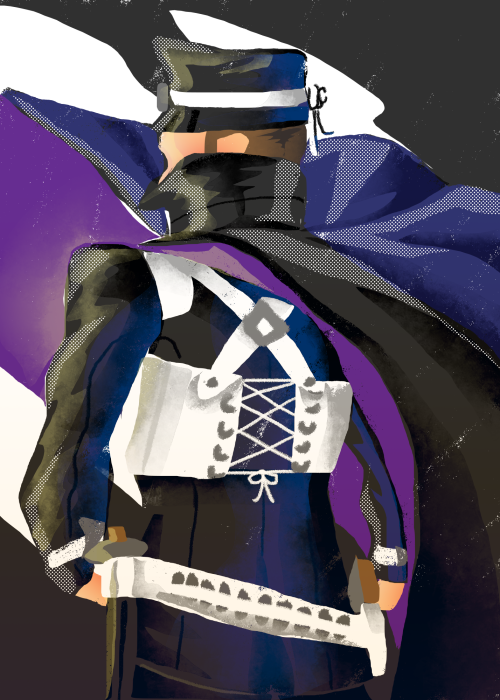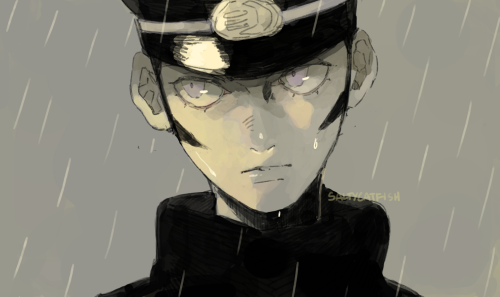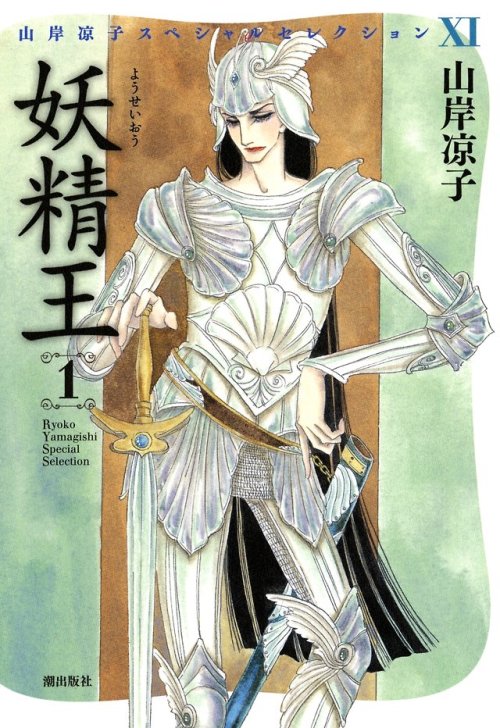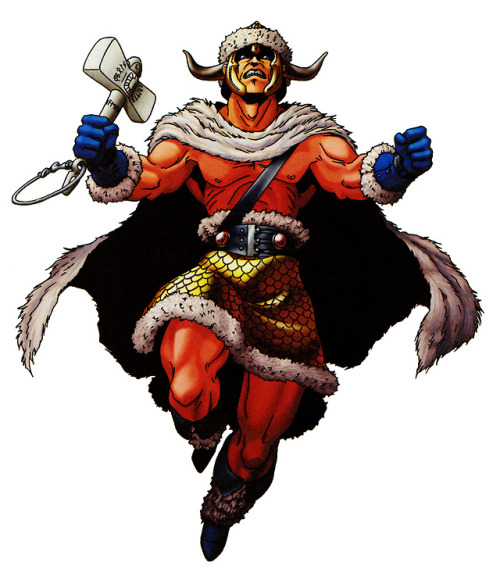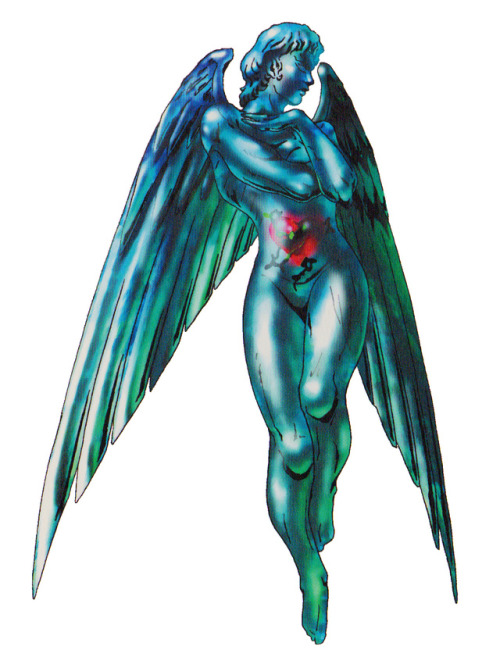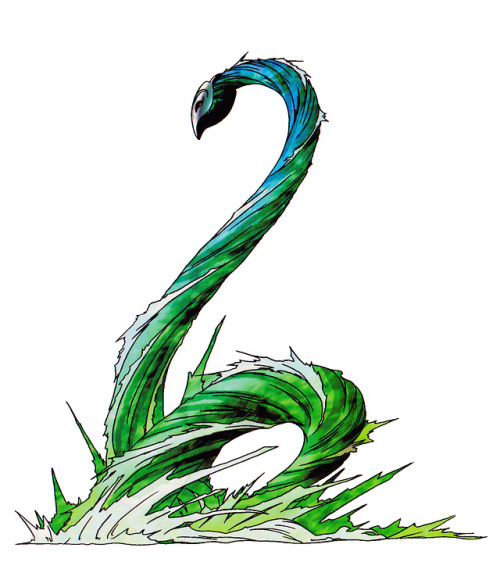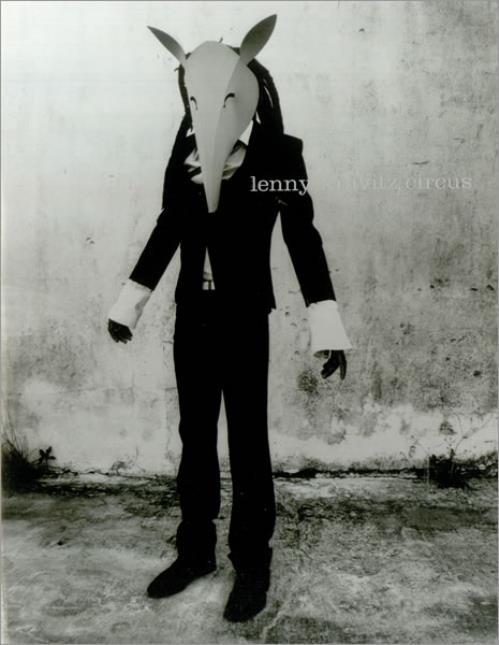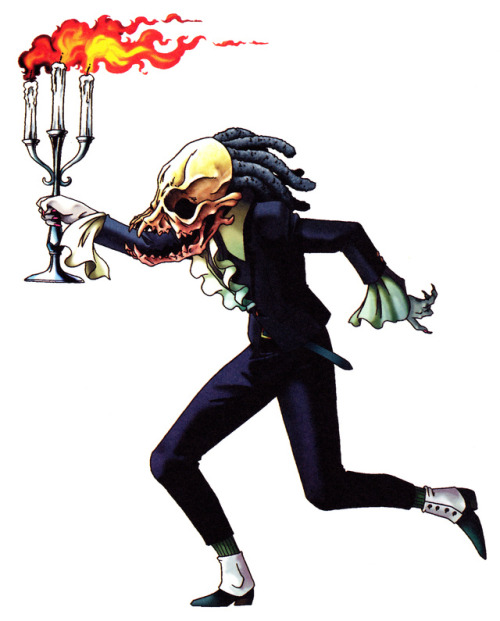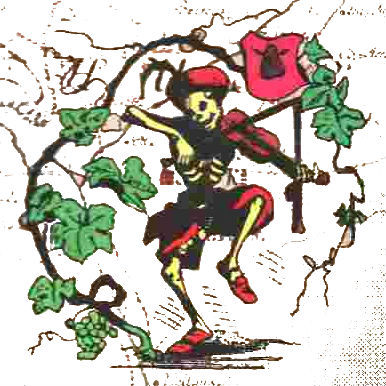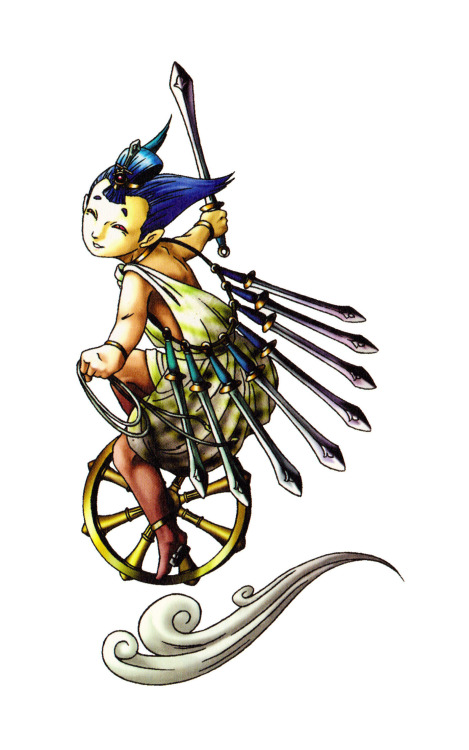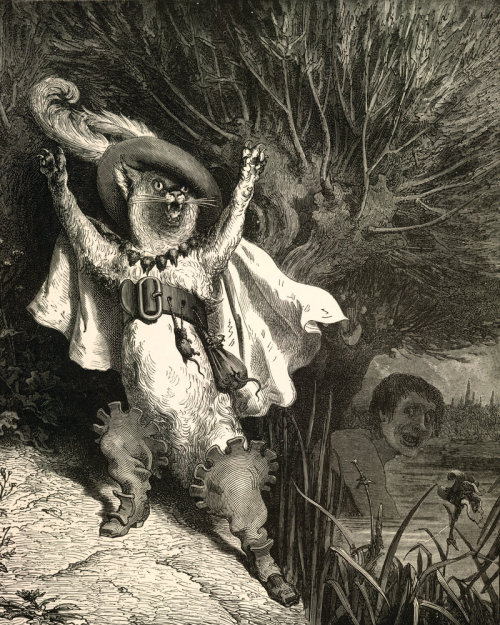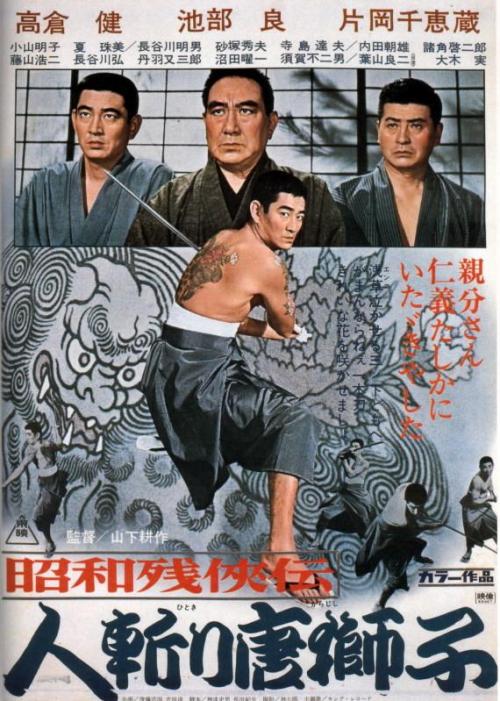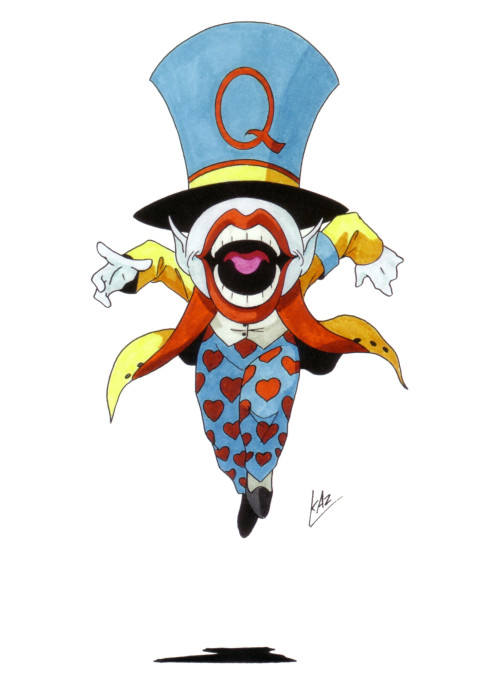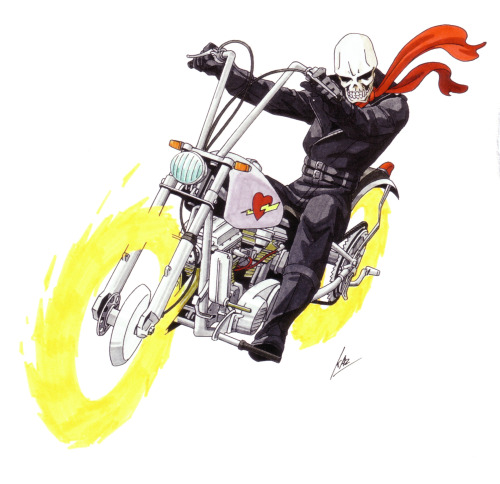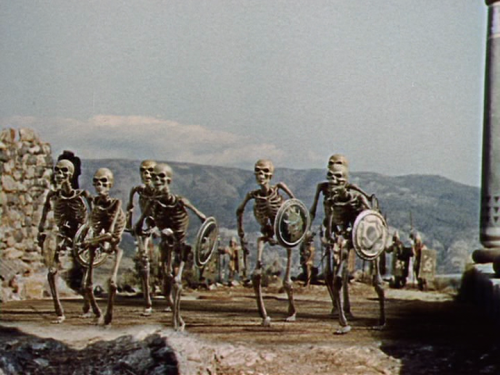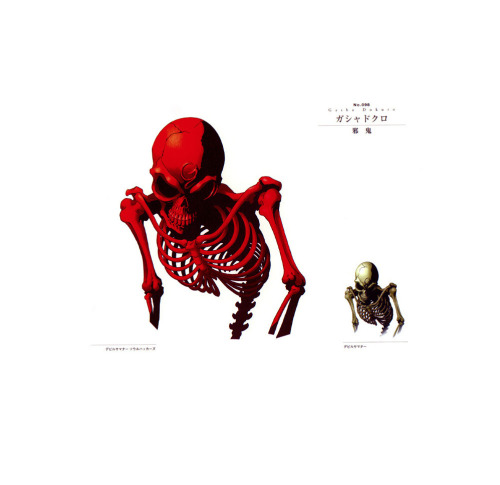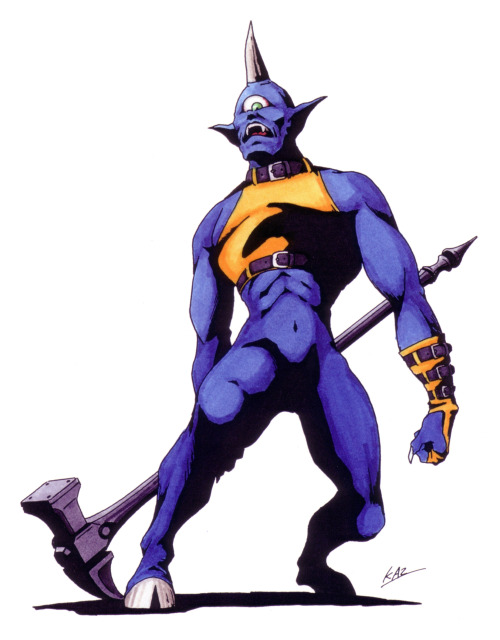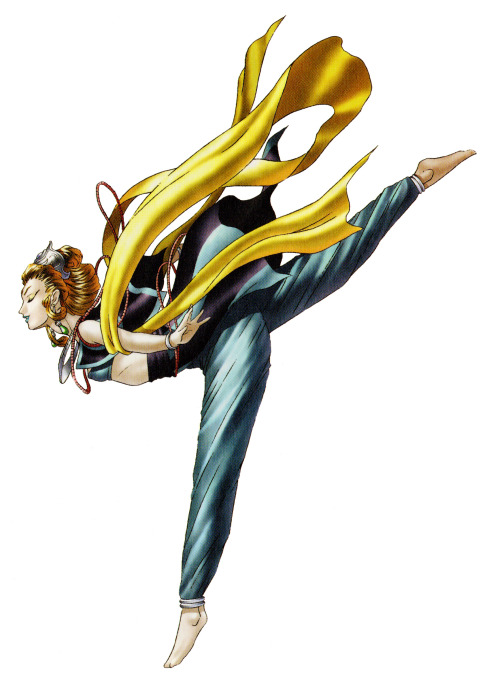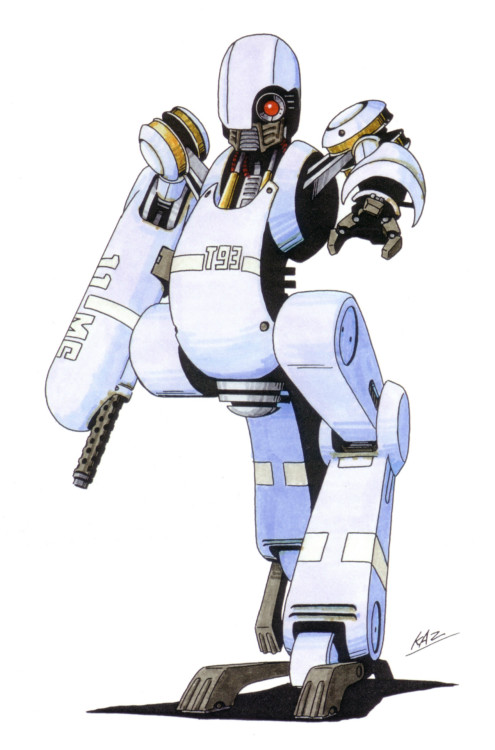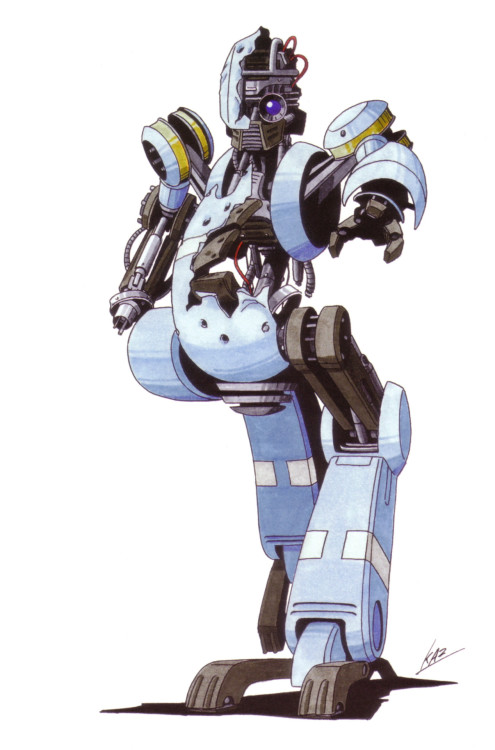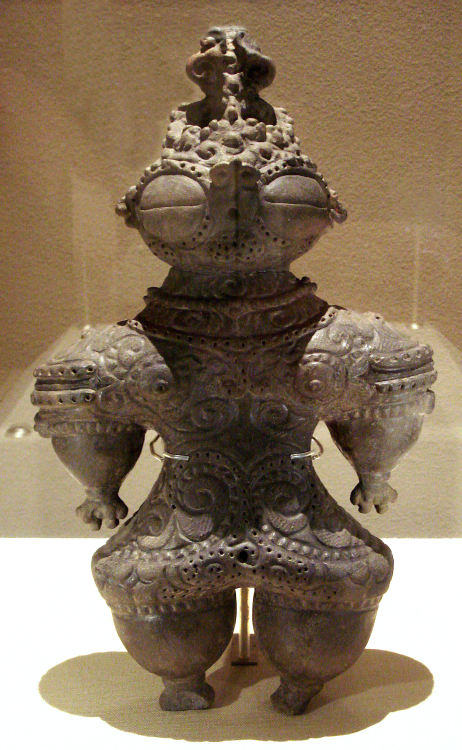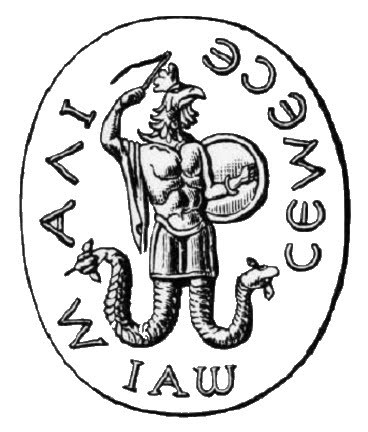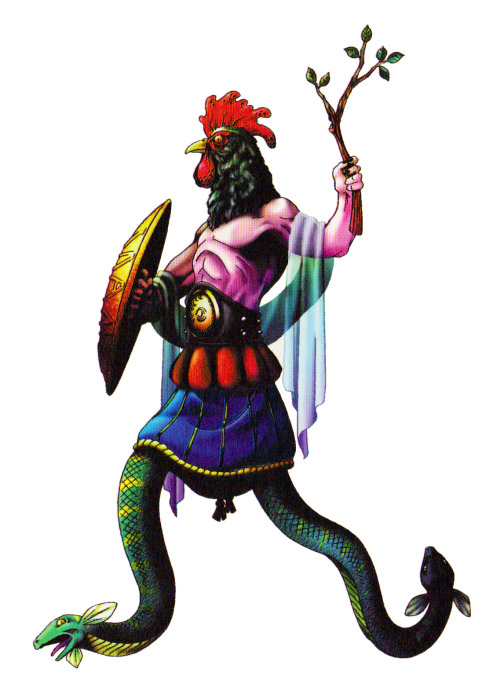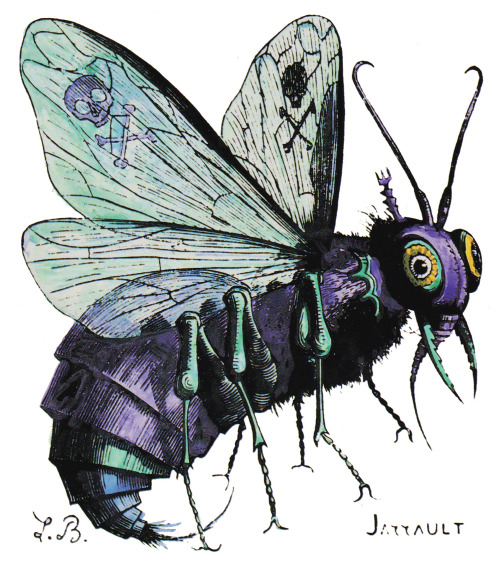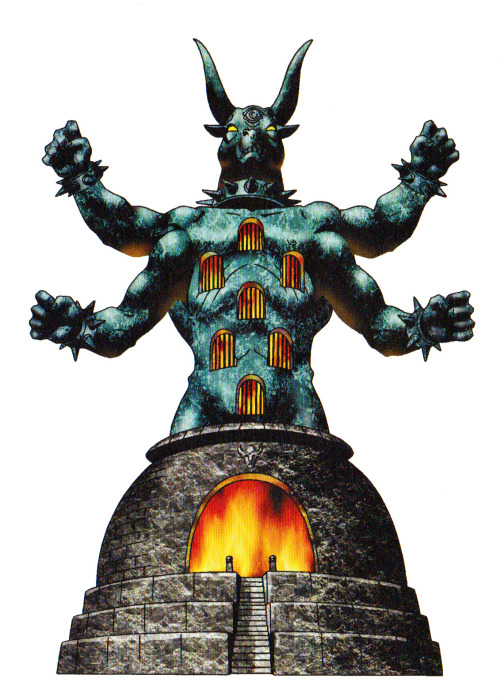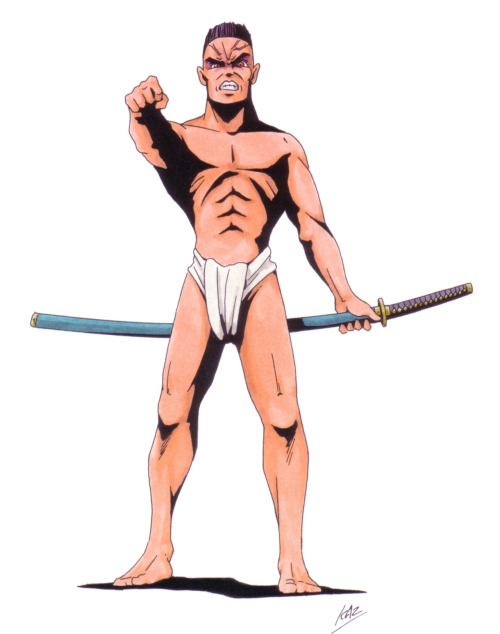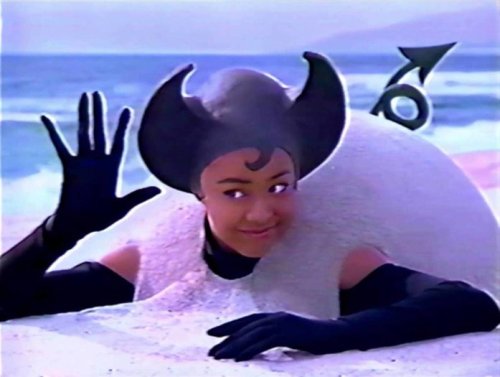#devil summoner

Complete scans courtesy of Vesp on Twitter!
Soul Hackers no Subete is a strategy guide released for Soul Hackers’ initial 1997 release for Saturn. It also received a later revision to coincide with the game’s PlayStation port but the two guides have almost completely different content! These scans are of the first edition that contains, among other things, Kaneko’s comments for every new demon design in Soul Hackers!Definitely check it out!
https://drive.google.com/file/d/1lCYh9050dCqE6UDvmCLhZ-GHDNT92IJV/view

I don’t think I did this prompt correctly, but I interpreted it as: redesign a protagonist in the franchise to fit an edgy superhero aesthetic. So, resigned Raidou? ¯\_(ツ)_/¯
Post link
I didn’t plan on liking this as much as I do, considering it wasn’t supposed to exist and took no time at all to make.
Post link
KANEKO’S CRIB NOTES LIX: NOW WE HAVE DEVIL SUMMONER WORLD GUIDANCE, HO-HO-HO
It’s the 2018 holiday season, which means Tumblr is about to become a smoldering crater. Until then, we’ve got some amazing new cribs for you courtesy of Devil Summoner World Guidance.DSWGis a solid demon art book with Kaneko comments for each of DS’s demons (a total of 275). Our gifts to you are the best five out of those mostly easily translated:
- Cu Chulainn: Finally on KCN! Kaneko’s is inspired by the Cu Chulainn in the obscure manga/anime Fairy King / Yousei-ou(妖精王). Technically the comments are about the Devil Summoner version but the SMT1 Cu Chulainn above makes for a better comparison to the manga art.
- Thor: DS’s “boring” Thor cribs mightily from Schwarzenegger’s Conan from Conan the Barbarian. Compare the beefy body, the fur-lined clothing, and especially the totally cribbed helmet. Just do it quickly, before Kratos savagely butchers him in God of War 2!
- Thanatos: This diseased dwarf is as unusual as they come, but Kaneko claims inspiration from two distinct sources: Okuyasu’s deformed father in Jojo’s Bizarre Adventure and Baron Harkonnen of Dune, presumably Kenneth McMillan’s pustulating portrayal from the 1984 film.
- Virtue: Virtue’s translucent body, while striking, has always been difficult to pin down but at last we know that it was intended as an homage to Claire, the glass/machine waitress of Galaxy Express 999: an odd but strangely appropriate visual for the angelic archetype.
- Rahu: Not merely an allusion to the idiomatic expression, Rahu’s craneal wang can apparently be traced back to the phallic pineal gland sported by Dr. Pretorius in Stuart Gordon’s cult classic From Beyond.
Post link
KANEKO’S CRIB NOTES LVIII: GREATEST HITTITE OF THE ‘70s
There’s little rhyme or reason to Kaneko’s influences sometimes, not that it’s a bad thing. Case in point: Shin Megami Tensei’s version of the Hittite serpent Illuyankaappears to be wearing the mask of Phantom of the Paradise’seponymous Phantom. We know what you’re thinking: what the hell is Phantom of the Paradise? A 1974 flop directed by noted filmmaker Brian De Palma (TheUntouchables,Scarface),Phantomchannels the same musical camp as The Rocky Horror Picture Show, only its relative obscurity means your friends won’t ruin it for you. Pardon the personal anecdote.
Anyway, The Phantom’s beaked mask is quite distinct and Illuyanka’s shares its shape and details right down to the ridges and stylized eyelashes. The Phantom’s mask seems to have made a splash in Japan overall, as its appearance can also potentially be seen in the helmet worn by Berserk’sGriffith/Femto; however, there’s no question that Kaneko was copying Phantom’s original, as Berserk’s differs in some key ways.
Many thanks to doctorchevlong for this crib!
Speaking of masks and phantoms, HAPPY HALLOWEEN and enjoy KCN’s very best selections from Samhain seasons past:
- ‘14: (1) Betelgeuse(2)Baphomet
- ‘15: (1) Season of the Crib, (2) Arachne
- ‘16: Spoo*y Skeletons
- ‘17:David’s Halloween Ghoul-a-ganza
Post link
KANEKO’S CRIB NOTES LV: LENNY KRAVITZ’S FESTIVAL OF INFERNAL LIGHTS
Lenny Kravitz once declared “Rock and Roll Is Dead,” but we’re pretty sure he didn’t light a candle over its grave…until now.
With Christmas upon us at last, we never expected that the incredibly belated (on multiple occasions) releases of the 4th and 5th volumes of the Kazuma Kaneko Worksseries would be as the Star of Bethlehem and lead us to one of the most astonishing cribs of all. As with the preceding three volumes, Kaneko Works 4and5 contain profile appendices for each of the featured demons, including what were assumed to be new descriptive notes and sources on designs from the 32-bit era. Unfortunately, many of these notes suggested design inspirations that seemed spurious at best, including one that noted that Bifrons’ design as seen in Devil Summoner and Soul Hackers (but Devil Summoner in particular) was based on musician Lenny Kravitz.
Though this connection seemed too good to be true and likely the mere conjecture of a new author with a surprisingly deep bed of pop culture references at hand, it turned out the design source mentions in particular originated not from Kaneko Works 4and5 but from the old Devil Summoner World Guidancebook, in Kaneko’s own words! Straight from the horse’s mouth: the Kravitz inspiration was real! (Click here to view the Bifrons blurbs from KW5andDS World Guidance.)
As seen in the gallery, Bifrons clearly resembles a costume Kravitz wore in promotion for his 1995 album Circus. Both wear a “puffy shirt” under a jacket and while Bifrons’ skull doesn’t seem to be that of a mouse’s to match Kravitz’s mask (but does in a way carry over his monstrous grin from the Dictionnaire Infernal), the demon retains the musician’s flowing dreadlocks. With the addition of a blazing candelabrum in reference to Bifrons’ spirited role, it’s yet another classic Kaneko pop culture crib to add to the pantheon!
Very special thanks to @poltergeist0002for confirming for us that the design comments originated in Devil Summoner World Guidance!
GHOSTS OF KCN PAST:
Post link
KANEKO’S CRIB NOTES LIV: DAVID’S HALLOWEEN GHOUL-A-GANZA + CASTLEVANIA…!?!
Thanks to matteste for this one! Originally spotted on the cover of the Swedish book Sällsamheter i Bohuslän och Dalsland, we were able to trace this death image’s presence to none other than the Dictionnaire Infernal (though not its actual origins; we’ll get into that). Featured in the dictionary’s entry for the “dance of death” (danse des morts), this skeletal musician looks as if it is delighting in fiddling away some macabre tune. Kaneko’s David adapts exactly the posture of raised left leg, the placement of the violin on the left shoulder, and especially the feathered beret.
A perplexing issue is the exact provenance of the Dictionnaire’s "David.” Louis Le Breton is famously credited for the book’s demon illustrations, but the skeleton violinist is unattributed; moreover, it just doesn’t look like it is in Le Breton’s style. No other artist is officially credited in the Dictionnaire, but a couple of the other illustrations in the “dance of death” entry are signed by that of Jean-Baptiste Victor Loutrel and E. Kretzschmar; we can find no confirmation that the work is theirs. It would also be tempting to credit Hans Holbein the Younger and his own Dance of Death woodcut series, but the illustration isn’t present there, either. Even more puzzling is the colorized version as seen on the Swedish book, as its crimson hue is an uncanny match for Kaneko’s Fiend–so where exactly did he see this? Certainly not on this book’s cover, unless he’s been a secret Suecophile all along! Unfortunately, all of these questions must remain unanswered for the time being.
While obviously meant to evoke the Danse Macabre of his Dictionnaire heritage, the appellation “David” is another matter altogether. Luckily avoiding confusion with the later Macabre, David’s likely namesake is instead one of the creations of the legendary Antonio Stradivari: the violinDavidoff Stradivarius, as evidenced by the weapon left behind following his defeat in the original SMT (’Stradivari”). Otherwise, looking for any connection between the name David and the genuine Danse Macabre tradition turned out to be a fool’s errand.
Lastly, since October is the month when we reflect on the dead, it’s the perfect time to include some Castlevania! Morbid, but you know it’s true. Anyway, while browsing the Dictionnaire Infernal we happened upon its entry for Amalaric, the Visigoth king, and found the general silhouette of his sniper assassin to be curiously familiar in both pose and the degree of the bow’s tilt to Castlevania: Symphony of the Night’sSniper of Goth(orAmalaric Sniper). While its angelic embellishments define the sprite, we figure this illustration has to be the inspiration for it as it’s such a bizarrely specific enemy otherwise!
Halloween ‘14: (1) Betelgeuse(2)Baphomet
Halloween ‘15: (1) Season of the Crib, (2) Arachne
Halloween ‘16: (1) Spoo*y Skeletons
Post link
KANEKO’S CRIB NOTES XLVIII: LITTLE GUYS
This one is for the little guy(s). The compendium isn’t all statuesque deities and that one yakuza guy: there’s plenty of room for the diminutive spirit or the dwarfish god, though many sit at the bottom of the food-chain in terms of level or are otherwise relegated to extreme obscurity. Such is the case with our slate for this month, but I’m sure you’ll find they’re inspired all the same!
- OTOGO-DOUJI:Our pal Douji has been a particular no-show following his debut in the Saturn era. His design is a fairly direct interpretation of classical depictions of the Gohou-Douji, a class of child-like protector deities in Japanese Buddhism. Kaneko’s rendition is decked out with the dharma-wheel and sword-garb sported by both the more common young boy variety pictured above and the hilarious child-man incarnation.
- BES:The perhaps equally obscure Bes is uniformly depicted as a pot-bellied dwarf with lolling tongue, so you can hardly hold it against Kaneko for playing a close game here. In a somewhat surprising move, he forgoes the opportunity to depict a certain appendage in favor a more modest combination of primate tail and stylish shorts, with an Eye of Horus medallion thrown in for flavor.
- CAIT SITH:It was only a matter of a time before Gustave Doré showed his face here, but not through his austere renderings of Dante and Milton, as luck would have it. No, Kaneko instead made the excellent choice of seeking inspiration from Doré’s depiction of the gallant Puss in Boots for his take on the Celtic Cait SIth (understandable, considering the dearth of traditional imagery for the latter). His lacks some of the more endearing qualities of the original, such as the accruement of bird skulls and dead mice, but the comparison otherwise speaks for itself.
Post link
KANEKO’S CRIB NOTES XLVI: JAPANESE “POP”
Kaneko is no stranger to swinging wide when it comes to contemporary popular culture, and while the man shares a particular fondness for the western variety, it should come as no surprise that some targets skew closer to home. Here are a few of the more relevant cases, in honor of the holiday season, or something.
- TATTOOED MAN: Even when you have a roster of 400+ demons in an SMT game, fellows like Tattooed Man make you question if his spot couldn’t have been better represented. But you can’t say he’s not inspired: Kaneko admitted as much in a 1999 interview when he said he loves the image of Japanese actor Ken Takakura in yazuka flicks. Sure enough, Tattooed Man and his slick crew cut are a match for Takakura in the movie Brutal Tales of Chivalry 2: The Chinese Lion and Peony Tattoo, with or without a certain cool customer on his back.
- GHOST Q: Not-so-subtle hints in artbooks confirm that SMTII’s Ghost Q is based on the incorporeal Q-tarō from the manga series Obake no Q-tarō, but, other than the comically large kissers, the only other clue is in the name itself.
- OKAMOTO: Aleph’s one-time trainer is pulling inspiration in both character and design from Danpei of Tomorrow’s Joe fame, another bummy but driven fight coach in the grand tradition of underdog boxing narratives. In fact, his design is practically just a sleek, nominally futuristic take on Tetsuya Chiba’s more beleaguered original - a Kaneko trademark!
- RAIDOU KUZUNOHA XIV: Raidou is channeling a no less appropriate source for his iconic design: Yasunori Kato of Teito Monogatari, one of the more notable pieces of occult pulp to influence the series. Kaneko manages to bend Kato’s Lieutenant attire into that of a Taishou era school uniform, and with his cloak down he’s a dead ringer for Amano’s original design.
Post link
KANEKO’S CRIB NOTES XLIV: SPOO*Y SKELETONS
Today’s the day! Our third annual Halloween spookfest is here, with even fewer cumbersome fleshy bits than ever. Cuz they’re all skeletons and shit! And you better believe they’re aping other successful career skeletons! HAPPY HALLOWEEN
- HELL BIKER: Hey. You know it. We know it. Hell Biker is just Ghost Rider. It’s shameless, but we don’t need to spend a minute more of our lives ruminating on it once we nod in its general direction with the acknowledgement that, yes, it is indeed something that happened over two decades ago now. There, that wasn’t so bad.
- SPARTOI:Sown from dragon’s teeth in Greek myth, the Spartoi were known as fierce warriors. However, they tended to be of the fleshytype. So why is Kaneko’s a skeleton? One need look no further than what is probably the most famous appearance of the Spartoi in pop culture, the Ray Harryhausen stop-motion skeletons from 1963’s Jason and the Argonauts.
- GASHADOKURO:He may be sporting a bit of a dye-job in his SH design, but otherwise we’re looking at some prime Gashadokuro here, right down to the obscured lower section. He’s even got a friendly reminder on his forehead in case he forgets!
Halloween ‘14: (1) Betelgeuse(2)Baphomet
Halloween ‘15: (1) Season of the Crib, (2) Arachne
Post link
KANEKO’S CRIB NOTES XLIII: HEADS-UP
As we explored in last month’s Crib, some demons are only repping hard from the neck-up. This happens to make for a nice middle-ground between inspiration and invention, so you won’t catch us complaining anytime soon! With that in mind, let’s take a look at some of the other notable cases of this phenomenon, with some extra cranium thrown in for good measure.
- HECATE:Hecate is no stranger to evocations that cash in on her tripartite nature, but these tend to skew on the human side of things. But as later depictions collected stronger associations with witchcraft and sorcery, a trio of animal-heads would sometimes make their way in, usually of the horse, dog, lion, and pig varieties. Pictured above is one such illustration from Natalis Comitis’s Mythologiae, just the sort that Kaneko seems to have channeled in this case.
- SATAN:Satan’s noggin seems to come from none other than H.R. Giger and his creation of the titular xenomorph from Ridley Scott’s 1979 classic Alien. Apparent on that original costume is that its elongated cranium contains a visible skull that, with its sleek transparent dome removed (as seen above in a production photo), bears more than a passing resemblance to Satan’s own. Thanks to “Bead Man” for the original suggestion.
- INTI:If you’ve ever seen the Sun of May, it may explain why Inti seems so familiar. The version of it from the Uruguayan flag, pictured above, seems in particular to have been Kaneko’s inspiration.
Post link
KANEKO’S CRIB NOTES XLI: ACTIVECONTINUITY
Cribs can originate from anywhere…even Kaneko’s own designs! Here’s a handful of examples of preceding designs influencing subsequent ones, whether in full or just certain elements. It’s exactly this kind of internal continuity that makes Kaneko so missed!
- NANDI/DEMI-NANDI:Shiva’s cheerful mount may not seem to have much in common with his mass-produced counterpart from Shin Megami Tensei II, but a closer look reveals a behavior passed on by the divine genes: A predilection for blowing raspberries.
- CYCLOPS/MAMEDANUKI:Shin Megami Tensei′s Cyclops is about as forgotten as they come, but his head was to find greater fame as the shape-shifting display of Mamedanuki’s magic scrotum.
- LAKSHMI: Kaneko often gave his SFC-era designs new palettes and shading in the Saturn era, but Lakshmi here is one of the few to be completely redrawn with a new pose, using the exact same wardrobe and likeness from her SMTI original. It’s especially apparent with the nigh-identical Devil Summoner version colors.
- T-93/JUNK:This little guy’s a trooper, having apparently weathered the turbulent interval between SMTI and II in one piece, albeit acquiring the unfortunate moniker of “Junk” and an appearance to match in the process.
Post link
KANEKO’S CRIB NOTES XXXVI: ARAHABAKI
We let this one slide for quite a while there, but better late than never; we’re talking Arahabaki, your Kofun pal with the flimsy rationale.
This one is… yeah, not exactly a thinker. The design is modeled after a Dogu, particularly the Shakoki-dogu, as pictured above. But whereas the Dogu originate in the Jomon period (14,000 - 300 B.C.), Arahabaki supposedly hails from the later Kofun era (250 - 538 A.D.). And while certain Dogu have been interpreted as representing goddess figures, it’s unlikely that any were actually meant to depict Arahabaki himself. As it stands, we might assume that Kaneko merely chose an iconic image of prehistoric Japan in order to emphasis the, uh, “ancientness” of the deity proper.
But it may not be so simple: depictions of Arahabakias a Doguor withDogu-like featuresare somewhat abundant throughout Japanese media, too much so to merely be a pattern of riffing on the iconic SMT design. Unfortunately, reliable sources for Arahabaki in English are painfully scarce, making it all the more difficult to discern whether or not the connection persists in any meaningful capacity beyond the orbit of popular media.
KCN is just getting started with Jomon-era Cribs. Check back next month for another whopper!
Post link
KANEKO’S CRIB NOTES XXIX: ABRAXAS
Abraxasis the other cock-headed demon in the Shin Megami Tensei compendium (besides Sindura and the original Basilisk–wait, who’d you think I meant?), though he sadly doesn’t appear as often as he should. What’s not to love about Abraxas? He’s a supreme being in Gnosticism no matter the source, with some serious celestial number symbolism going on–whether his name is inscribed as Abraxas or the variant Abrasax, the Greek system of isopsephy, which assigns number values to letters, assigns A-B-R-A-X-A-S the sum of 365. That’s quite the obvious celestial number that appears repeatedly in mythology; for another example, Biblical patriarch Enoch lived for 365 years.
Abraxas is famously depicted on the so-called Abraxas stones, where he is seen as a chimeric being called the Anguipede, with serpents for legs. One of the most notable Abraxas stones is included in the photoset above. It’s apparent that Kaneko used that stone as the inspiration for Devil Summoner’s Abraxas, as it shares tiny details right down to the fins on the serpents’ heads, though does exchange Abraxas’ usual whip for a branch.
Hey, it could have been worse. Imagine if Kaneko’s design model was instead the 1990 sci-fi disasterpiece Abraxas: Guardian of the Universe, starring former wrestler/ex-Minnesota governor/modern conspiracy nut Jesse Ventura in the eponymous role, an “intergalactic police officer.”

And you can’t say it wouldn’t be thematically appropriate, as Abraxas: Guardian of the Universe is a supreme cosmic monstrosity all 365 days of the year!
Post link
KANEKO’S CRIB NOTES XXVIII: ARCHDEMONS APLENTY
We all love demons. We love them so much that it’s become increasingly hard to write a brand new deck for all these KCN posts without repeating myself. But that’s quite all right, we are pretty sure people are here for the pictures and not the text. So, I’m just going to write enough sentences to make a full paragraph. Now that it’s done, here’s another large photoset for everyone to enjoy:
1. BELPHEGOR:
Louis Le Breton was a dear old man
He drew Belphegor sitting on the can
Kaneko thought Louis’ version was true
But traded chamberpot for modern loo
Raidou 2 features Belph’s old potty style
A fiend of sloth, he’ll be busy a while
2. BEELZEBUB: Shin Megami Tensei’s Beelzebub is based on the version from the Dictionnaire Infernal, with the skull and crossbones motif on the wings. Everybody knows that. But did you knowthat a colorized version of the original Le Breton Beelzebub art (seen above) appears in Fred Gettings’ 1988 Dictionary of Demons(subsequently published in Japan in 1992), its purplish hues a plausible influence for those the Shin Megami Tensei II design?
3. CHEMOSH/MOLOCH: This one is a close enough match for the 18th century illustration of “The Idol Moloch”, pictured above. The six openings and three-layered pedestal are replicated faithfully, along with the general aspect, while Kaneko opts towards an appropriately “punk” spiked collar + wristband combo. Appropriate for the pagan idol par excellence, anyhow.
4. PAZUZU: Speaking of pagan idols, here we have a dead ringer for an iconic 8th century statuette, which most will likely recall from 1973 smash hit The Exorcist. The design is left mostly intact, save for the inclusion of a hoary mane and a formidable accruement of body hair, while the original MTII design offers a bit more in the way of embellishment.
Post link
KANEKO’S CRIB NOTES XXV:THE HUMAN ELEMENT
Esoteric alchemical illustrations and ancient art aren’t the only inspiration for the ol’ creative spark here at KCC. Kaneko has been known to occasionally look to the wide world of contemporary pop-culture for inspiration, as is perhaps appropriate to the primarily modern setting of the series. With that in mind, it’s time to take account of some of the real (or nominally real) life figures that have left their mark on the vast design catalogue over the years.
- BUTCHER:The mononymous “Butcher” offers a fairly literal take on the moniker of one-time wrestling extraordinaire Abdullah the Butcher, depicted here as a sort of crazed Messian executioner, title belt prominently displayed.
- NEMISSA:Nemissa is nothing short of a dead-ringer for Marianne Faithfull as she appears in the 1968 cult classic The Girl on a Motorcylce,sporting the iconic leather jacket/jumpsuit combo. This one is almost especially egregious save for the inclusion of some nominally stylish bell-bottoms on part of the former.
- STEPHEN:Resident science symbol and long-time demon fenangler Stephen is, of course, a supremely unsubtle nod to the acclaimed theoretical physicist of the same name. While the concept art itself doesn’t make for the best likeness, his in-game sprite is a bit more forward.
- GOTOU:The head honcho of the early Gaean faction is a none-too thinly veiled stand-in for renowned author and nationalist icon Yukio Mishima, both pictured above with rippling bod™ and tasteful fundoshi in tow. Like Stephen, his role in the narrative is at least partially informed by the character of his real-life counterpart.
- ALP:This iconic spirit of German folklore is largely inspired by the mascot of a short-lived ad campaign for Calpis Water that premiered during the early 90′s, starring actress Goto Kumiko as some sort of thirsty devil hell-bent on burglarizing parched civilians in search of the lightly flavored beverage, only to be foiled at the last minute by the various and cruel machinations of both fate and primitive green-screen technology.
Big props once again to dijeh for the scoop on Alp’s inspiration via his translation series and to turnipfritters for the hot tip on Nemissa! (KCN never forgets)
Post link
KANEKO’S CRIB NOTES XXIII: GOGMAGOG
Here’s one that’s been on the KCN hit-list for as long as we’ve been in business: Gogmagog, the giant menace of Albion from way back when.
Pictured above is one of the many samples of prehistoric art adorning the walls of Tassili n’Ajjer - quite a trip from the British isles. This one in particular is an example of the manycarvings of “giants” found around sites such as Jabbaren, some panning out at a whopping eighteen feet high. Or perhaps you’ve seen them referred to elsewhere as “Martian gods”, placing the poor saps within an entire realm of delightful crackpot silliness.
Gogmagog himself lacks any really compelling iconography of his own to till from, so it’s no surprise that Kaneko felt the need to look elsewhere for inspiration. The connection might seem fairly tenuous to begin with, but the prehistoric art motif makes for a comfy match with his evolutionary hombre, Albion.
Shout-out to dijeh for providing the hot tip on this one, via this series of translations - design comments straight from the horse’s mouth. Go check it out if you haven’t already!
Post link






